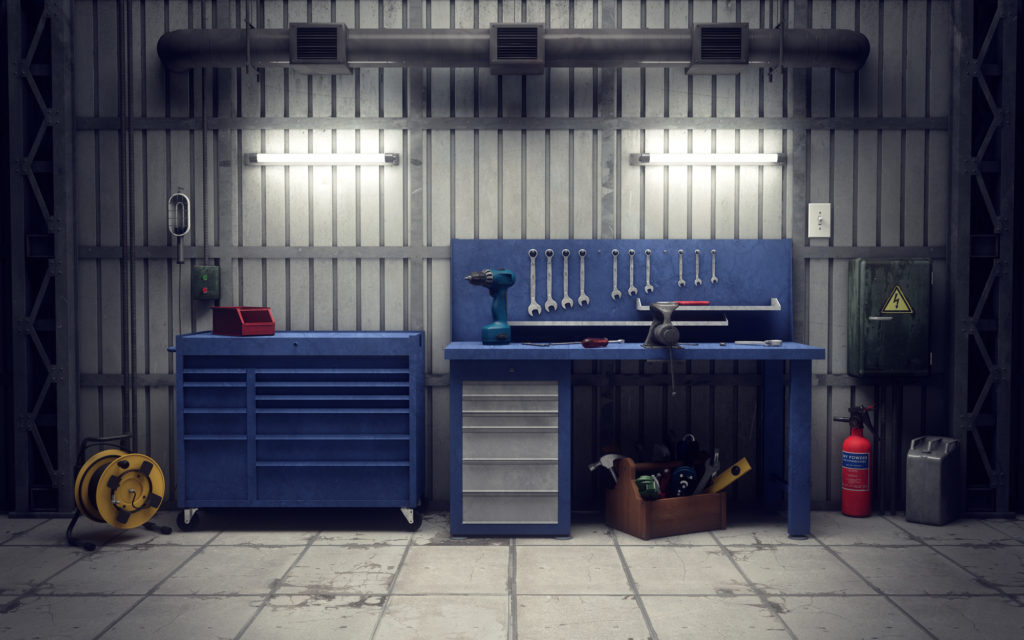
DIY projects range from the fairly straightforward to the very complex. On the straightforward side, you might go in for a house-wide deep cleaning. On the complex side, you might try your hand at remodeling your bathroom.
A need for decent workshop tools is the common factor that unites almost all DIY projects. Sooner or later, you’ll find that you must cut plywood or sand the wood you got for that upcycling project.
We’ll assume that your workshop already has the essential basics, like screwdrivers, wrenches, hammers, and a drill. This one is for the passionate DIYer looking to up their game.
So let’s dive in and look at the 5 workshop tools you should look at picking up next.
1. Portable Table Saw
In most workshops, the table saw functions as the workhorse at the heart of most projects.
It can cut sheet goods into pieces or trim a 1/4 inch off the edge of a board. You can cut bevels into the wood. Dado blades let you cut grooves for shelves or rabbets for backing material.
What really makes the table saw so useful is that you can make repeated, consistent cuts. Once you set the fence, everything is the same width every time.
Portable table saws these days come with a lot of the bells and whistles you see on professional table saws. You can get very accurate fences with some of the better portable table saws on the market. Most portable table saws even allow for the use of dado blades and offer dado throat plates.
Most DIYers let a basement or garage pull double duty as their workshop, so space comes at a premium. In terms of space saving, it’s all about the stand. You can get a stand for most brands that fold down and roll.
This drastically reduces the saw’s footprint when not in use. It also lets you park the saw in a corner to get it out of the way.
2. Miter Saw
No serious DIYer can go for long without a reliable miter saw.
A basic miter saw does two things. It cuts boards to the proper length and lets you cut an angle across the board. Much like the table saw, the key value here lies in repeatability.
Let’s say you must replace the trim around a door. You need at least four cuts at 45 degrees. Cutting four, straight, perfect 45-degree angles with almost any other saw poses serious challenges.
Once you set that 45-degree angle on a miter saw, though, every cut is a straight, perfect 45-degree angle.
You get more features as you move up in the quality of saw, such as:
- bevel cuts
- sliding cuts
- laser alignment
3. Router
The router is one of the most versatile workshop tools out there.
Right at first, most people use routers to put decorative edges on their projects. While routers certainly excel at that function, but they have several other functions, like:
- cutting dados
- cutting rabbets
- making custom trim
- cutting patterns into wood
- cutting large circular pieces of wood
Routers come in several types, most notably trim, fixed-base, and plunge routers. Each type of router presents pros and cons.
Trim routers cost less and often prove the easiest to use. As a general rule, though, they lack the power you need for large, hardwood projects.
Fixed-base routers typically provide plenty of power for any project. The main limitation of fixed-base routers is that you must start on an edge. While some people use fixed-base routers for plunge router work, it’s not really safe.
Plunge base routers let you start wherever you need to start, which makes them ideal for making mortises. Learning the ins and out of properly setting and adjusting the router is the biggest challenge.
For more information about picking a router, visit this website.
4. Nail Gun and Air Compressor
Installing molding along the floor with a hammer and nails is pretty doable. Installing crown molding along your ceiling with a hammer and nails is misery. Gravity works against you and it’s almost impossible not to hit the molding with the hammer.
A nail gun makes molding installation and a lot of other things easier. For example, let’s say you want a basic storage cabinet to store those must have woodworking tools.
Sure, you can pre-drill holes and then drive in some screws. Shooting some nails takes a lot less time and effort.
Of course, most nail guns run on air pressure. That means you can’t really use the air gun without the air compressor.
The upshot is that an air compressor lends itself to other useful tasks, such as:
- applying finish
- filling your tires
- blowing the dust off tools or projects
- painting
- changing tires
5. Random Orbit Sander
For DIYers and professionals alike, sanding is one of those necessary evils. Everyone hates it and no one escapes it. Sanding is like paying taxes that way.
Like most other tools, sanders come in several varieties. The random orbit sander probably provides the most versatility for the avid DIYer.
It has the power to take a fair amount of material off of wood, which is great for rough work. It’s also gentle enough to get a clean, smooth surface.
The other thing that sets the random orbit sander apart is the sanding pattern. The sander actually moves the sandpaper in two ways.
The sanding pad spins the actual sandpaper across the surface. The sander also vibrates the entire pad in small circles as well. You get two simultaneous circular motions.
This approach leaves far fewer visible scratches in the wood.
Parting Thought on Workshop Tools for DIYers
To some extent, the projects you do define which workshop tools are essential.
That said, most passionate DIYers will use the tools mentioned above over and over again. They provide you with the options you need for almost every DIY project.
If you already own most of these tools, consider some benchtop tools like a jointer, drill press, and bandsaw. They’ll open up new possibilities for DIY projects.
Thinking about taking your DIY efforts up a notch with a roof replacement? Check out our roofing materials guide.

